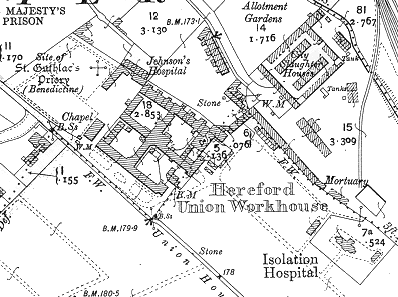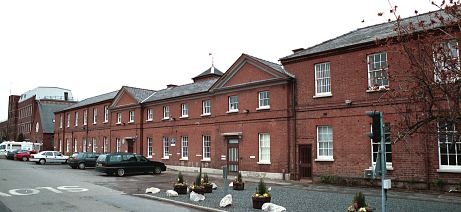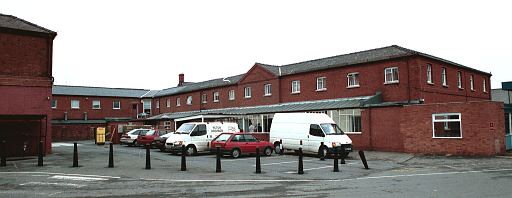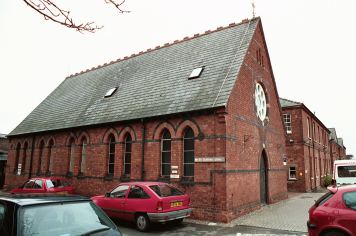Hereford, Herefordshire
Up to 1834
In 1697, following the example of Bristol in the previous year, Hereford successfully promoted a private Act of Parliament (9 & 10 William III, c.34) for the "erection of hospitals and workhouses for better employing and maintaining the poor." Whether any workhouse was erected under this Act is unclear. By the 1770s, five of the city's parishes were operating their own small workhouses: All Saints (up to 18 inmates), St John Baptist (20), St Martin (7), St Nicholas (10), and St Peter (15).
Eden, in his 1797 survey of the poor in England, reported of Hereford that:
Prior to the formation of the Hereford Poor Law Union, the city appears to have had three workhouses, one in All Saints parish, one in St John's, and one in Quaker's Lane (now Friars Street).
After 1834
Hereford Poor Law Union was formed on 28th April 1836. Its operation was overseen by an elected Board of Guardians, 53 in number, representing its 45 constituent parishes as listed below (figures in brackets indicate numbers of Guardians if more than one):
County of Hereford:
Aconbury, Amberley, Bartestree, Little Birch, Much Birch, Boulston, Breinton, Upper Bullingham, Lower Bullingham, Upper Bullingham, Burghill and Tillington, Callow, Clehonger, Credenhill, Little Dewchurch, Much Dewchurch, Dewsall, Dindor, Dormington, Fownhope, Grafton, Hampton Bishop, Hereford All Saints (3), Hereford St John Baptist (2), Hereford St Martin (2), Hereford St Nicholas (2), Hereford St Owen (2), Hereford St Peter (3), Holmer and Shelwich, Horn Lacy, Huntington, Kenchester, Lugwardine, Marden, Mordiford, Morton-on-Lug, Pipe and Lyde, Preston Wynne, Stoke Edith, Stretton Sugwas, Sutton St Michael and Sutton St Nicholas, Tupsley, Wellington, Westhide, Weston Beggard, Withington
Later Additions: Allensmore (1837), Dinmore (1858), Eaton Bishop (1837), Haywood (1858), The Vineyard (1862).
The population falling within the Union at the 1831 census had been 23,075 — ranging from Amberley (population 27) to Hereford All Saints (2,905). The average annual poor-rate expenditure for the period 1833-35 had been £10,352 or 9s.0d. per head of the population.
The first meeting of the Board of Guardians took place in April 1836 at the Shirehall. A new Union workhouse for 250 inmates was built in 1836-7 to the north-east of Hereford on the south side of Commercial Road, for which the Poor Law Commissioners authorized an an expenditure of £5,600. The architect was John Plowman who was responsible for other Herefordshire workhouses at Dore, Ross. His design followed the popular cruciform or "square" plan with an entrance block at the front, behind which lay the four accommodation wings or 'ranges' radiating from a central hub, creating yards for the different classes of pauper (male/female, old/young). The workhouse location and layout are shown on the 1903 OS map:

Hereford site, 1903.
The building was complete in the autumn of 1837, and in August of that year advertisements were placed in the Hereford Times for the posts of Master and Matron, porter, cook, chaplain, nurse schoolmaster and schoolmistress. Supplies for the were workhouse were also opened to tender. These included mattresses, blankets, sheets and clothing for the inmates — for the men this consisted of jackets of strong 'Fernought' cloth, breeches or trousers, striped cotton shirts, cloth cap and shoes. For women and girls there were strong 'grogram' gowns, calico shifts, petticoats of Linsey-Woolsey material, Gingham dresses, day caps, worsted stockings and woven slippers. ('Fernought' or 'Fearnought' was a stout woollen cloth, mainly used on ships as outside clothing for bad weather. Linsey-Woolsey was a fabric with a linen, or sometimes cotton, warp and a wool weft — its name linked by some to the village of Lindsey in Suffolk, or simply derived from "Lin" (an old name for flax) and "wool". Grogram was a coarse fabric of silk, or of mohair and wool, or of a mixture of all these, often stiffened with gum.)
The workhouse had an entrance block at the south which featured two entrances, presumably one for males and one for females. The entrance block was extended at each end sometime before 1888.

Hereford entrance block from the south, 2001.
© Peter Higginbotham.
To the rear, the east range originally contained the dining hall, with the kitchens at the north and south of the central hub.

Hereford south and east ranges from the south-east, 2001.
© Peter Higginbotham.
Infirmary blocks for men and women were constructed across the north of the workhouse between 1876 and 1888. A chapel, also dating from before 1888 was erected to the west of the workhouse.

Hereford chapel from the west, 2001.
© Peter Higginbotham.
Work performed by the inmates included oakum picking, stone breaking, pounding bones and cleaning hair. The workhouse had extensive vegetable gardens and its own piggery which produced food for the inmates. The extent of this activity is indicated by the appointment of a farm manager in 1850.
In 1903, following criticisms from official inspectors about the ageing and insanitary state of the workhouse, it was debated whether to erect a new workhouse on a different site or to remodel the existing premises. However, no substantial improvements were made until 1937 when a large modern hospital was erected on the site of St Guthlac's Priory at the north-west of the workhouse.
In 1907, the Master and Matron of the workhouse were a Mr and Mrs Harding. Their son, Gilbert Harding, who was born at the workhouse, later went on to become a well-known radio and TV personality in the 1950s on shows such as Twenty Questions and What's My Line?.
The workhouse later became Longfield Buildings Poor Law Institution, later Public Assistance Institution, and then Hereford County Hospital.
During the Second World War, the hospital facilities were taken over as part of the Emergency medical Service scheme. The remaining Public Assistance residents were transferred to Bromyard, Ledbury and Leominster.
Children's Home
By 1908, the Hereford Union had established a children's home at Ivy House, 218 Ledbury Road, Hereford. It could house 32 children. The property no longer exists.
Staff
Inmates
Records
Note: many repositories impose a closure period of up to 100 years for records identifying individuals. Before travelling a long distance, always check that the records you want to consult will be available.
- Herefordshire Archives and Record Centre, Fir Tree Lane, Hereford HR2 6LA. Limited holdings include: Guardians' minute books (1836-1930); Children's Home Committee (1910-30) ; etc.
Bibliography
- The County Hospital by D Herrod (articles in The Press, 1980).
- The Poor Law in Hereford 1836-51 by Sylvia A Morrell (in Woolhope Naturalists Field Club, 1974-5)
Links
- None.
Unless otherwise indicated, this page () is copyright Peter Higginbotham. Contents may not be reproduced without permission.


